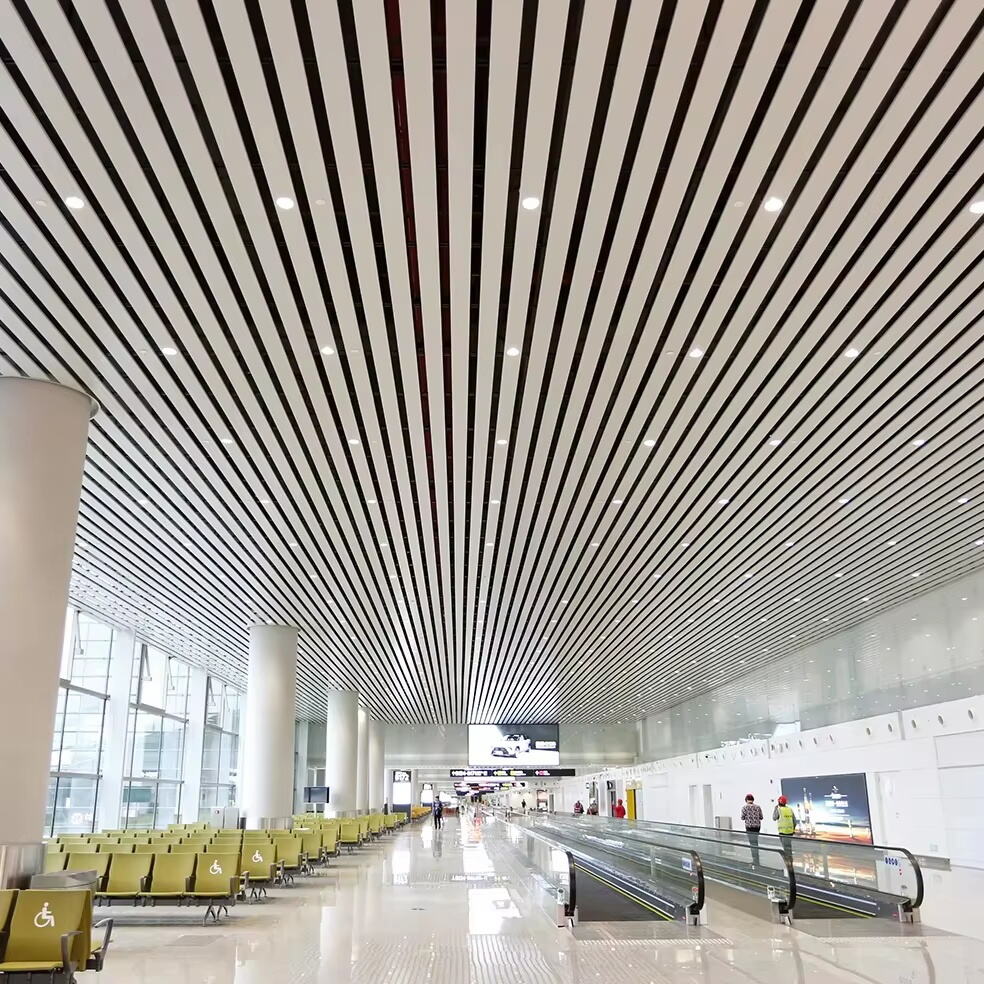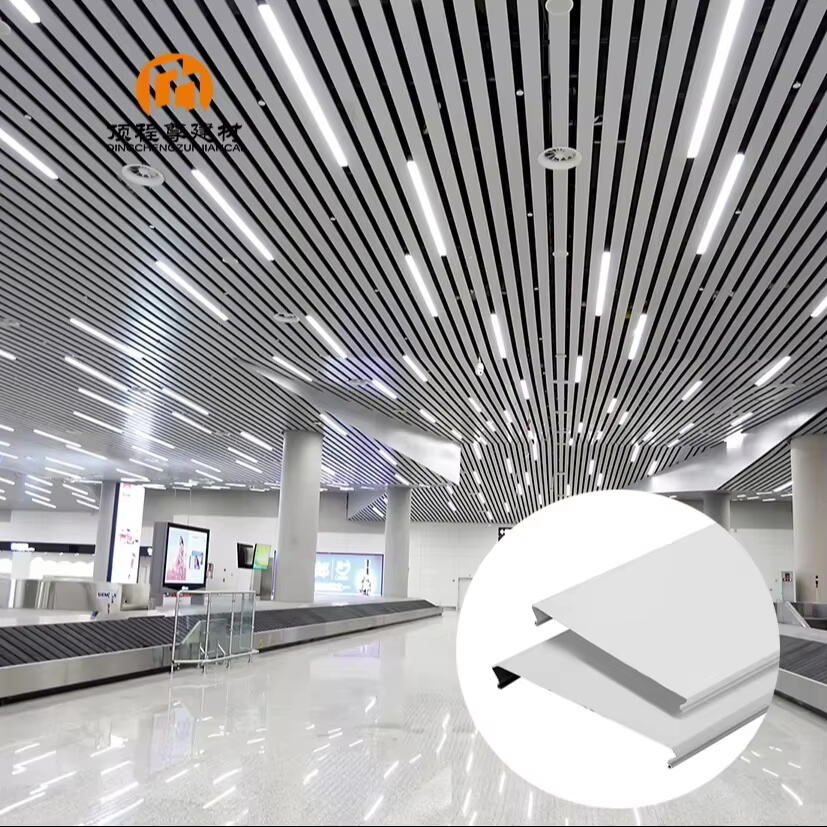Design Aesthetic: Linear Modernity vs. Classic Uniformity
Strip Ceiling: Sleek Lines and Customizable Configurations
Strip ceilings really capture the essence of modern design with those long, straight lines that just blend right into any room without drawing too much attention. People love them because they bring that clean, uninterrupted look that fits so well with today's minimalist and contemporary styles. The best part? Designers can play around with different setups to match whatever vibe they want for a space. Take minimalist interiors for example these days, strip ceilings have become kind of a staple element. Their simple lines just make everything feel calmer and more put together. Some recent market research actually shows that more homeowners are going for modern looks these days, and strip ceilings keep showing up as one of the top choices when it comes to updating older homes with something fresh and current.
Traditional Ceiling: Timeless Simplicity and Uniform Surfaces
People love traditional ceilings because they just feel right somehow. They have those smooth, even surfaces and old fashioned designs that make spaces feel cozy and familiar. Homeowners who appreciate heritage and classic architecture tend to gravitate toward these types of ceilings. Take a walk through any historic district and chances are good most buildings will feature these kinds of ceilings, whether it's the ornate details of Victorian homes or the clean lines of Georgian structures. Market research shows that demand for traditional ceilings remains strong, particularly when folks are renovating older properties. Many want to keep that authentic charm intact rather than going for something completely modern. There's just something comforting about walking into a room with a ceiling that looks like it belongs there.
Material Choices: Metal/Wood Strips vs. Plaster/Mineral Fibers
When looking at what goes into making different types of ceilings, there's a clear difference between strip ceilings made from metal or wood versus traditional ones that use plaster or mineral fibers. Metal and wood strips tend to last longer and look really modern, which makes them popular in contemporary spaces. Plaster and those mineral fiber options have that old school look people love in traditional homes. The metal strips get a lot of praise because they're tough and give off that clean, polished vibe. Wood strips can warm up a room nicely but need some extra care if there's any moisture around. On the other side of things, plaster brings real structural integrity along with that timeless charm, although it does weigh more and generally needs someone who knows what they're doing to install it properly. Most homeowners these days want something that looks good and works well together. Recent market data shows an interesting shift happening, with many preferring materials that combine style with practical benefits for their ceiling projects.
Lighting Integration: Built-In Innovation vs. Fixed Fixtures
Strip Ceiling: Seamless LED Channels and Ambient Effects
Strip ceilings changed how we think about lighting in modern spaces by incorporating those sleek LED channels right into the ceiling itself. The effect is pretty amazing actually – instead of harsh spots or flickering bulbs, rooms get this soft even glow that just wraps around everything. What makes them really stand out though? They can change colors and adjust brightness levels too! I've seen them work wonders in both small apartments where people wanted mood lighting for date nights, all the way up to big office buildings needing different lighting setups for meetings versus after hours work sessions. And let's talk numbers for a second. LEDs eat way less electricity than old fashioned bulbs did back in the day. My neighbor replaced her whole house lighting system with LED strips last year and cut her monthly bill almost in half while still getting better light quality. Combine all this with how good they look and it's no wonder designers keep coming back to strip ceilings again and again when planning new projects.
Traditional Ceiling: Recessed Lighting and Central Fixtures
Most traditional ceilings still go with recessed lights and those big central fixtures for basic lighting needs. People love them because they bring that classic look while making certain areas stand out in a space. Take recessed lighting for instance it just sits right in the ceiling without drawing attention to itself, giving off light that doesn't interrupt the room's overall appearance. Unlike those flexible strip ceilings we see more of lately, old school lighting stays pretty much the same everywhere, casting straightforward beams of light that just feel familiar somehow. Lighting designers keep pointing out how well these traditional methods work for setting moods in rooms, and sales figures back this up showing folks of all ages still prefer these kinds of lighting solutions. There's something reassuring about sticking with classic designs that just makes sense to most home owners looking for comfort over constant change.
Dimming Flexibility and Color Temperature Options
These days, being able to adjust light levels and change color temperatures is really important when designing spaces people actually want to live in. Strip ceilings stand out because they come packed with tech that lets homeowners tweak brightness and warmness exactly how they like it. Regular old lighting systems just don't cut it anymore since most only give fixed options without much flexibility. People know lighting affects how we feel inside a space. Experts keep pointing out that warmer lights create cozy vibes while cooler tones make rooms feel more alert and focused. Market research keeps showing more folks are asking for lighting they can customize as interior design becomes all about making spaces reflect personal style rather than sticking to standard looks. Looking at all this, strip ceilings clearly win when it comes to both practicality and creating the right atmosphere in any room.

Installation Complexity: Modular Systems vs. Labor-Intensive Framing
Strip Ceiling: Lightweight Panels and Tool-Free Assembly
Lightweight panel systems are changing how we think about ceiling installations, as these strip ceilings really cut down on labor requirements and make everything less complicated. What makes them stand out is the fact that most of these panels don't need tools for assembly, which means faster installs all around. Contractors love the shorter time spent onsite and the money saved, so it's becoming popular across different types of buildings. One flooring company actually told me their crew finished what would normally take weeks in just days when they switched to these strip systems instead of regular ceilings. The numbers back this up too, with many installers reporting around 50% less time needed for jobs compared to older methods. This kind of speed difference definitely helps keep construction schedules on track and reduces headaches for everyone involved.
Traditional Ceiling: Structural Support and Plasterwork Demands
Old school ceilings need way more hands-on work because of all the structural supports and plaster stuff involved. Installing them means bringing in pros who know their way around tricky jobs like custom framing and intricate plaster details, and that usually slows things down quite a bit. Contractors we talked to mention how tough it is working with these traditional methods nowadays when there are better options available. The numbers back this up too traditional installs typically run anywhere from two to four weeks and cost significantly more money since they rely heavily on experienced workers putting in long hours. Strip ceilings just don't have those same headaches or price tags attached.
Timeline Comparison: Days vs. Weeks
Looking at how long things take to install, strip ceilings definitely win out here. They usually get done within a few days while traditional ones might drag on for weeks. Take one business we worked with recently - they had this massive retail space needing renovation. We used modular systems there and finished up way faster than anyone expected. No huge interruptions to their operations and saved them a bundle on the bottom line too. Contractors who've seen both approaches will tell you straight up that making the switch changes everything about what projects can realistically accomplish. Modular stuff just moves quicker and works better overall. The numbers back this up pretty clearly too. What takes weeks with standard ceilings gets knocked out in days when going modular, which is why more and more folks are making the change these days.
Space Perception: Illusion of Dimension vs. Defined Boundaries
Strip Ceiling: Height Enhancement and Visual Expansion
Strip ceilings really help make rooms feel taller and more open no matter where they're installed. Both at home and in offices, these kinds of ceilings use straight lines that guide the eyes upwards, which tricks us into thinking there's more headroom than there actually is. People who live or work in tight spaces especially appreciate this trick because it creates that much needed feeling of room to breathe. Design pros will often combine strip ceilings with smart lighting choices and colors that complement each other to get even better results from the space. Some studies suggest that how we feel inside a room has a lot to do with what's going on above our heads too. A good ceiling design isn't just about looks it actually affects how comfortable we feel in our surroundings.
Traditional Ceiling: Solid Surfaces and Cozy Enclosure
Traditional ceilings give rooms a completely different feel compared to modern alternatives, emphasizing solidity and warmth instead. Solid ceiling surfaces actually help define where one area ends and another begins in a space, which makes people feel more comfortable and secure in their surroundings. Many homeowners still prefer enclosed spaces because they just feel cozier, especially when looking at older houses built with classic designs. Looking at architecture history, traditional ceilings have been around for centuries and serve both looks and function by clearly marking off different parts of a home. Market research consistently shows most people want some mix of open areas with enough enclosed sections for privacy and comfort, something that remains true across various housing segments today.
Impact on Room Functionality (Residential vs. Commercial)
What kind of ceiling we choose really makes a difference in how well a room works, whether it's at home or in business settings. Take strip ceilings for example they're pretty common in office buildings and retail stores because they help with lighting and sound control, which makes those spaces much more functional overall. Industry pros say these kinds of ceiling systems play a big role in making sure commercial spaces work better for meetings, presentations, or just day to day operations. Residential spaces tend to go for the old fashioned solid ceilings though. People seem to prefer them at home since they create that sense of enclosure and quietness everyone wants when relaxing after work. Looking at real world examples shows that both ceiling types do their job well in different contexts. Strip ceilings make commercial areas more productive while traditional ceilings give homes that cozy feel most homeowners look for.
FAQ
What are strip ceilings?
Strip ceilings involve sleek, continuous lines crafted through customizable configurations, often made from materials like metal and wood.
What materials are commonly used for traditional ceilings?
Traditional ceilings often use plaster or mineral fibers to create uniform and classic surfaces.
Can strip ceilings be used in residential spaces?
Yes, strip ceilings are versatile and can be applied in both residential and commercial settings to enhance modern aesthetics.
How does lighting integration differ between strip and traditional ceilings?
Strip ceilings offer built-in LED channels with customizable effects, whereas traditional ceilings use recessed lighting and fixed fixtures for classical illumination.
Is the installation process for strip ceilings more efficient?
Yes, strip ceilings use modular systems, allowing for tool-free assembly, which significantly cuts down installation time compared to traditional ceilings.


